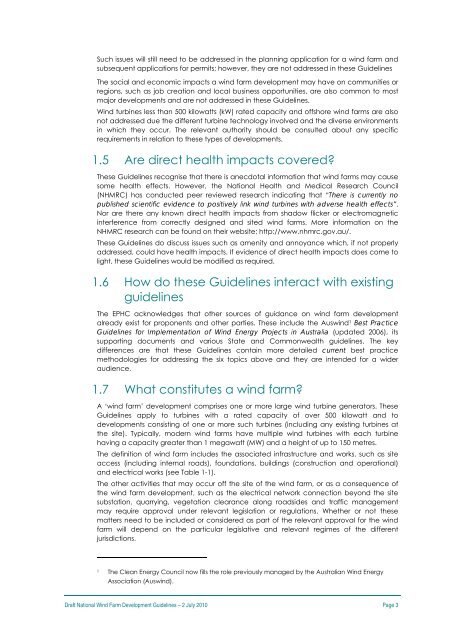Draft National Wind Farm Development Guidelines - July 2010
Draft National Wind Farm Development Guidelines - July 2010
Draft National Wind Farm Development Guidelines - July 2010
Create successful ePaper yourself
Turn your PDF publications into a flip-book with our unique Google optimized e-Paper software.
Such issues will still need to be addressed in the planning application for a wind farm and<br />
subsequent applications for permits; however, they are not addressed in these <strong>Guidelines</strong><br />
The social and economic impacts a wind farm development may have on communities or<br />
regions, such as job creation and local business opportunities, are also common to most<br />
major developments and are not addressed in these <strong>Guidelines</strong>.<br />
<strong>Wind</strong> turbines less than 500 kilowatts (kW) rated capacity and offshore wind farms are also<br />
not addressed due the different turbine technology involved and the diverse environments<br />
in which they occur. The relevant authority should be consulted about any specific<br />
requirements in relation to these types of developments.<br />
1.5 Are direct health impacts covered<br />
These <strong>Guidelines</strong> recognise that there is anecdotal information that wind farms may cause<br />
some health effects. However, the <strong>National</strong> Health and Medical Research Council<br />
(NHMRC) has conducted peer reviewed research indicating that “There is currently no<br />
published scientific evidence to positively link wind turbines with adverse health effects”.<br />
Nor are there any known direct health impacts from shadow flicker or electromagnetic<br />
interference from correctly designed and sited wind farms. More information on the<br />
NHMRC research can be found on their website; http://www.nhmrc.gov.au/.<br />
These <strong>Guidelines</strong> do discuss issues such as amenity and annoyance which, if not properly<br />
addressed, could have health impacts. If evidence of direct health impacts does come to<br />
light, these <strong>Guidelines</strong> would be modified as required.<br />
1.6 How do these <strong>Guidelines</strong> interact with existing<br />
guidelines<br />
The EPHC acknowledges that other sources of guidance on wind farm development<br />
already exist for proponents and other parties. These include the Auswind 1 Best Practice<br />
<strong>Guidelines</strong> for Implementation of <strong>Wind</strong> Energy Projects in Australia (updated 2006), its<br />
supporting documents and various State and Commonwealth guidelines. The key<br />
differences are that these <strong>Guidelines</strong> contain more detailed current best practice<br />
methodologies for addressing the six topics above and they are intended for a wider<br />
audience.<br />
1.7 What constitutes a wind farm<br />
A ‘wind farm’ development comprises one or more large wind turbine generators. These<br />
<strong>Guidelines</strong> apply to turbines with a rated capacity of over 500 kilowatt and to<br />
developments consisting of one or more such turbines (including any existing turbines at<br />
the site). Typically, modern wind farms have multiple wind turbines with each turbine<br />
having a capacity greater than 1 megawatt (MW) and a height of up to 150 metres.<br />
The definition of wind farm includes the associated infrastructure and works, such as site<br />
access (including internal roads), foundations, buildings (construction and operational)<br />
and electrical works (see Table 1-1).<br />
The other activities that may occur off the site of the wind farm, or as a consequence of<br />
the wind farm development, such as the electrical network connection beyond the site<br />
substation, quarrying, vegetation clearance along roadsides and traffic management<br />
may require approval under relevant legislation or regulations. Whether or not these<br />
matters need to be included or considered as part of the relevant approval for the wind<br />
farm will depend on the particular legislative and relevant regimes of the different<br />
jurisdictions.<br />
1 The Clean Energy Council now fills the role previously managed by the Australian <strong>Wind</strong> Energy<br />
Association (Auswind).<br />
<strong>Draft</strong> <strong>National</strong> <strong>Wind</strong> <strong>Farm</strong> <strong>Development</strong> <strong>Guidelines</strong> – 2 <strong>July</strong> <strong>2010</strong> Page 3
















